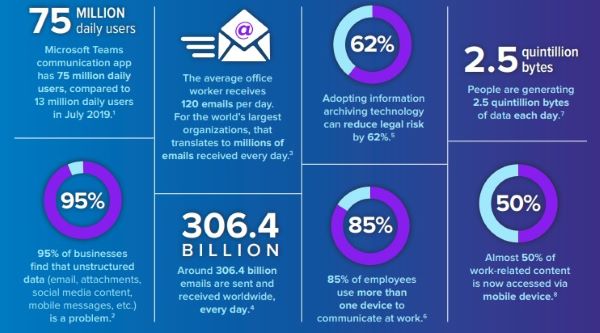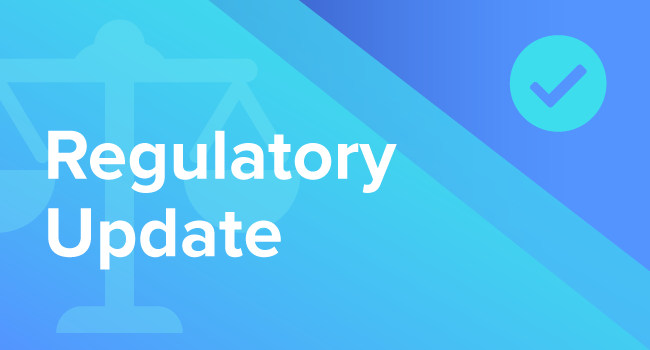Future-Proofing Your Communications Archive
It’s hard to dispute that data is valuable. However, putting it to use for your organization has become increasingly more challenging now that people produce 2.5 quintillion bytes of data (and counting) of increasingly varied types (voice, emojis, etc.) every day. And that volume is only going up, especially when it comes to electronic communications data.
The sudden and lasting shift to remote work during the pandemic has been a catalyst for many organizations to adopt new tools for communication. As organizations transition from in-person meetings, presentations and even large-scale professional conferences to virtual events, communication and collaboration tools are proving to be invaluable.
The number of active daily Microsoft Teams users has skyrocketed, from 13 million in July 2019 to more than 75 million in less than a year. Teams is one of many collaboration and communication tools crucial to enabling productivity while allowing employees to safely work from home.
Collaboration and compliance in the enterprise
Unfortunately, modern communication tools also bring with them a multitude of regulatory compliance concerns. For compliance teams, safeguarding against non-compliance by adapting policy and processes is top of mind as their organizations work to ensure business continuity. The rapid adoption of multiple communication channels requires the retention and oversight of growing volumes and varieties of data — email, instant messages, video conferences and all the other tools employees use to do their jobs.
In the same turn, 85% of employees use more than one device to communicate at work. A single conversation often spans more than one device and communication channel. This creates a logistical challenge for compliance and IT teams who are tasked with making sure their organizations can reliably capture and archive those communications.
For example, if a conversation started in email and then carried over to Teams, organizations without a centralized communications archive would have to wrangle those messages from disparate locations. This is inefficient and time-consuming and can make an audit, investigation or regulatory exam that much more difficult.

Business continuity for regulated organizations
Business continuity requires extra focus on ensuring that an organization can weather big changes — even despite a major event. In regulated industries, those organizations must have a tailored archiving and monitoring approach that can support the communication needs of all departments, across all regions.
As enterprises look to strategically realign their processes to contend with the explosion of data and the increased variety of communication channels, they must consider cloud-based, scalable, extensible technology solutions that can support their efforts today and in the future.
Cloud-based, scalable, extensible technology
Cloud storage: More than 95% of Fortune 500 companies use Microsoft Azure for cloud storage services. Microsoft Azure can support limitless storage capability to fit the demands of exponential data growth, and customers can be assured their data will always be easily accessible and securely protected.
Communications capture: A modern communications archive should be able to capture and preserve data from all popular channels and devices, including text messages, email, and content generated on most social media applications and collaboration platforms.
Extensible architecture: Compliance can be a strategic part of the business. With APIs for content ingestion and data enrichment, organizations can integrate their archive with a range of third-party solutions and get more value and insights from their data.
The combination of an enterprise-grade archiving solution with enterprise-grade cloud storage gives organizations the tools to manage regulatory compliance efficiently and effectively and stay competitive in an always-evolving world. Compliance teams can easily access and manage data and be prepared for ongoing changes in the communication landscape.
To learn more about how to prepare for the future of communications archiving, check out this infographic.
Share this post!
Smarsh Blog
Our internal subject matter experts and our network of external industry experts are featured with insights into the technology and industry trends that affect your electronic communications compliance initiatives. Sign up to benefit from their deep understanding, tips and best practices regarding how your company can manage compliance risk while unlocking the business value of your communications data.




Subscribe to the Smarsh Blog Digest
Subscribe to receive a monthly digest of articles exploring regulatory updates, news, trends and best practices in electronic communications capture and archiving.
Smarsh handles information you submit to Smarsh in accordance with its Privacy Policy. By clicking "submit", you consent to Smarsh processing your information and storing it in accordance with the Privacy Policy and agree to receive communications from Smarsh and its third-party partners regarding products and services that may be of interest to you. You may withdraw your consent at any time by emailing privacy@smarsh.com.
FOLLOW US